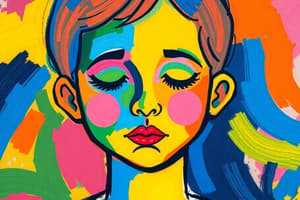Podcast
Questions and Answers
What is a key characteristic of social media that affects interpersonal communication?
What is a key characteristic of social media that affects interpersonal communication?
- It eliminates the need for any form of communication.
- It requires physical presence for interaction.
- It allows for asynchronous communication. (correct)
- It focuses solely on real-life interactions.
Which type of disinhibition involves positive online behavior?
Which type of disinhibition involves positive online behavior?
- Virtual invisibility
- Toxic disinhibition
- Personal introjection
- Benign disinhibition (correct)
What factor contributes to people adopting different identities in online interactions?
What factor contributes to people adopting different identities in online interactions?
- Virtual invisibility (correct)
- Public accountability
- Physical appearance
- Face-to-face communication
How does social media facilitate self-expression compared to traditional communities?
How does social media facilitate self-expression compared to traditional communities?
Which of the following does not contribute to online disinhibition?
Which of the following does not contribute to online disinhibition?
What is the primary influence of family as a social group in human development?
What is the primary influence of family as a social group in human development?
Which system in Bronfenbrenner's Ecological Systems Theory represents the immediate environment that directly impacts an individual?
Which system in Bronfenbrenner's Ecological Systems Theory represents the immediate environment that directly impacts an individual?
Which layer of Bronfenbrenner's theory focuses on the interactions between different components of the microsystem?
Which layer of Bronfenbrenner's theory focuses on the interactions between different components of the microsystem?
In the context of cultural influences, what does the term 'culture' primarily encompass?
In the context of cultural influences, what does the term 'culture' primarily encompass?
How does the exosystem indirectly affect an individual's development?
How does the exosystem indirectly affect an individual's development?
What aspect of human development is encompassed by the macrosystem?
What aspect of human development is encompassed by the macrosystem?
What does the chronosystem in Bronfenbrenner's theory account for?
What does the chronosystem in Bronfenbrenner's theory account for?
Which of the following best describes how communities influence cultural beliefs?
Which of the following best describes how communities influence cultural beliefs?
What does the chronosystem primarily focus on?
What does the chronosystem primarily focus on?
Which of the following best describes individualism according to the Individual-Collectivism Model?
Which of the following best describes individualism according to the Individual-Collectivism Model?
What major change in perspective regarding individualism and collectivism is observed in the Philippines?
What major change in perspective regarding individualism and collectivism is observed in the Philippines?
In the context of the Ivs.ME theory, what does the 'Me' represent?
In the context of the Ivs.ME theory, what does the 'Me' represent?
What is a key aspect of Urie Bronfenbrenner's Bioecological Systems Theory?
What is a key aspect of Urie Bronfenbrenner's Bioecological Systems Theory?
Which statement accurately reflects collectivist values as practiced in the Philippines?
Which statement accurately reflects collectivist values as practiced in the Philippines?
What significant aspect does the chronosystem consider about an individual's development?
What significant aspect does the chronosystem consider about an individual's development?
Which of the following is an example of a shift towards individualistic behavior in the Philippines?
Which of the following is an example of a shift towards individualistic behavior in the Philippines?
Flashcards are hidden until you start studying
Study Notes
The Self and its Social Agencies
- Human development is shaped by membership in crucial social groups.
- Social groups influence various aspects of the self, including belief systems, values, orientation, and behaviors.
- Family: The first, most pervasive, and influential social group.
- Schools & General Academic Environment: Exposure to diverse people in different social learning environments expands worldviews.
- Communities: Cultural beliefs and practices are influenced by community and societal dictates.
Culture
- Culture encompasses knowledge, belief, law, art, morals, custom, and habits acquired by individuals as members of society.
- Socially transmitted and learned by groups of people bound by ethnicity, geography, and personal orientations.
- Varies geographically, traditionally, and individually.
Bioecological Systems Theory
- Proposed by Urie Bronfenbrenner in 1935.
- Explains individual social development through biological, environmental, and ecological lenses.
- Highlights the bidirectional influence of individual systems on each other.
- Consists of five specific systems that shape an individual's sense of self:
Bronfenbrenner's Ecological Systems Theory
- Microsystem: Immediate and impactful environment where an individual directly interacts. Includes family, school, peers, and caregivers.
- Mesosystem: Connections and interactions between components within the microsystem. For example, relationships between family and school or interactions between home and community contexts.
- Exosystem: Social settings that indirectly impact development. Examples include a parent's workplace or local government policies.
- Macrosystem: Broader cultural context, societal norms, values, and economic conditions. Encompasses cultural beliefs, customs, laws, and societal resources.
- Chronosystem: Dimension of time within an individual's lifespan and the historical context. Considers changes and transitions over time and their impact on development. Historical events, life transitions, and sociohistorical circumstances are part of the chronosystem.
Individual-Collectivism Model
- Proposed by Hazel Rose Markus and Shinobu Kitamaya in 1991.
- Individualism: Focuses on individual attributes and personal distinctiveness. Individuals are more independent in achieving goals.
- Collectivism: Values relationships and harmony. Individuals prioritize group goals and cooperation.
Individual-Collectivism Model in the Philippine Context
-
The Philippine society is traditionally viewed as collectivist.
-
Collective interests are prioritized over personal interests.
-
Relationship functionality is maintained through practices that benefit everyone.
-
Examples: Choosing careers that fulfill family expectations, staying in one home, attending masses as a family, and sharing achievements.
-
Many Filipinos are adopting individualistic perspectives due to globalization and influence from countries with individualistic mindsets.
-
Examples: Moving out after graduation, pursuing careers based on individual interests.
I vs. Me
- A theory posited by Herbert Mead in 1934.
- An individual's behavior differs in solitary and social settings.
- "I": The unsocialized self (Who am I?)
- "Me": The socialized self (What do others think about me?)
The Socio-Digital Self
- In the past, relationships were established solely through face-to-face interactions.
- Technology enables people to interact even when not physically present.
Social Media
- Websites and applications that facilitate information sharing, idea exchange, and interest expression.
- Allows people to create virtual communities and networks for self-expression.
- Features enable communication with specific groups sharing common interests.
Social Media and the Self
- Participation in virtual environments can affect a person's sense of self.
- Cyberspace allows people to create multiple digital identities and behave differently in online settings.
- People can redefine themselves on the internet.
Online Disinhibition Effect
- Occurs when people engage in behaviors they wouldn't in real-life situations due to adopting fake identities.
- Two Categories:
- Benign Disinhibition: Increased self-disclosure or acts of kindness online.
- Toxic Disinhibition: Using rude language, bullying, and engaging in inappropriate content online.
Why Online Inhibition Happens
- Anonymity: Lack of accountability.
- Virtual Invisibility: Lack of physical cues.
- Asynchronous Communication: No immediate consequences.
- Personal Introjection: Identification with online characters.
Studying That Suits You
Use AI to generate personalized quizzes and flashcards to suit your learning preferences.



